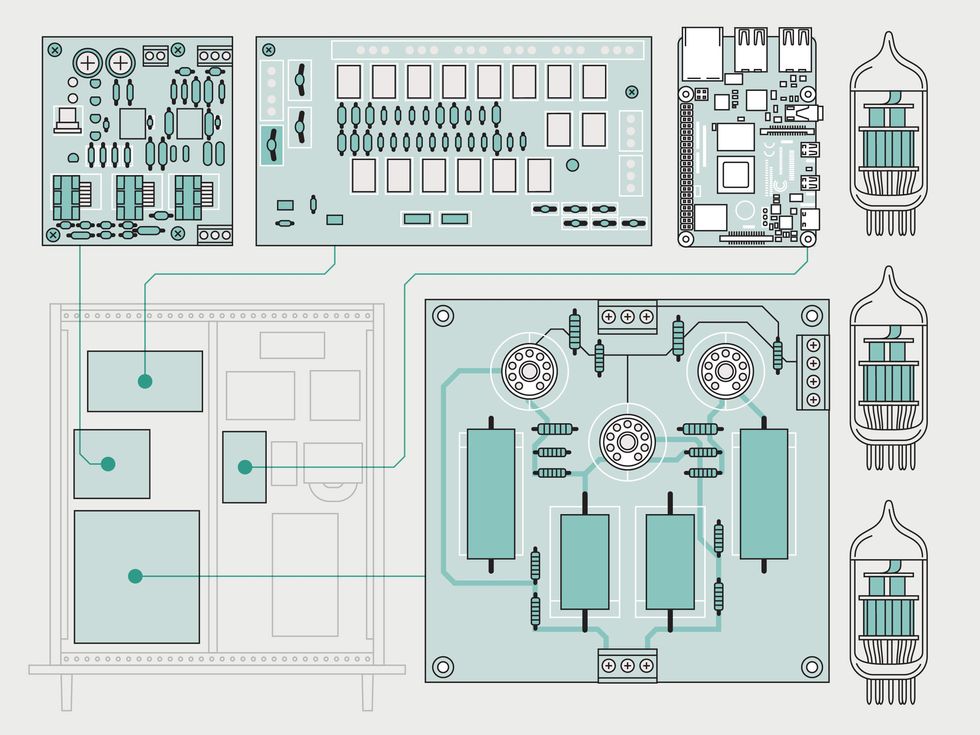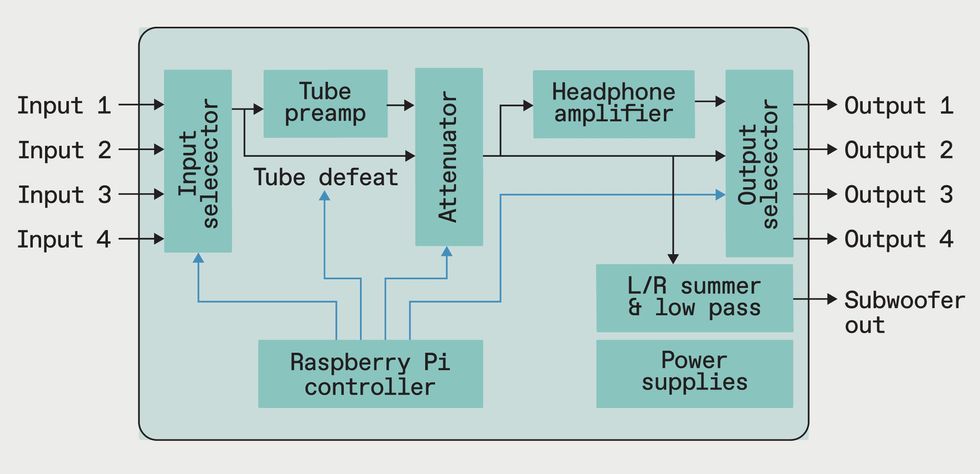A Web-Enabled, High Quality, DIY Audio Amp

For a long time I owned a beloved Sansui Electric integrated amplifier. These audio amplifiers combine a preamplifier for boosting the sound signal and a power amplifier for driving the loudspeakers. Sansui went out of business several years ago, and, although old units can still be found, when my amplifier finally died a crackly death, I decided it was time to consider something modern and more flexible. And I'd already built my own speakers, so why not build it myself?
Researching home-brew audio sites, I came across Glenn Zorpette's November 2018 Hands On article, DIY Pro Audio" in IEEE Spectrum, and it convinced me it was possible, although I wanted to go beyond just a power amplifier to something more like my lamented Sansui. I also wanted to add volume and input/output controls. And a headphone amp. And use tubes, oh my!
So consider this a spiritual successor to Zorpette's 2018 amplifier. The first thing I tackled was the volume control. I wanted to use a relay-based volume control that controls the volume in discrete steps to eliminate the noise that can accompany traditional analog volume controls. I scoured eBay for relay-based controls but realized that they still have potentiometers: An analog-to-digital converter reads the voltage coming out of the pot and energizes the corresponding relays-even a new pot could be noisy.
So I decided to drive my own relays digitally and control them via a Web interface. No knobs or switches to wear out! I located a similar project by Jos van Eijndhoven online and decided to use his approach of employing a ladder of attenuating resistors, which would give me 64 distinct volume steps without introducing audible distortion. To this board I also connected a tap along with a low-pass filter and output-just in case I decide to build my own subwoofer speaker!
 My preamplifier uses a combination of custom and off-the-shelf components, including a headphone amplifier and a digital attenuator I made myself [top left, top middle] and a wireless-enabled Raspberry Pi [top right] and a Zerozone 3-tube amplifier [bottom right and right]. The remaining components are a collection of power supplies.
My preamplifier uses a combination of custom and off-the-shelf components, including a headphone amplifier and a digital attenuator I made myself [top left, top middle] and a wireless-enabled Raspberry Pi [top right] and a Zerozone 3-tube amplifier [bottom right and right]. The remaining components are a collection of power supplies.
I decided on a Raspberry Pi 4 with 4 gigabytes of memory as my controller. In commercial product development, an optimized microcontroller would be the way to go, but for my DIY project, a Pi was perfect. It has lots of input/output pins for hardware interfacing, and it's easy to develop on. My final design needed only 300 lines of Python code (including the Web server), and 500 lines of HTML/JavaScript. I was able to make a professional-looking Web interface by using g200kg's webaudio-control library of graphical user-interface widgets.
The power supply was my biggest headache because of the number and range of voltages needed
For preamplification, I've always loved the sound of tubes. After some reading, I settled on buying a Zerozone design based on three 12AU7 tubes (which are still being manufactured today). I chose a 12AU7-based design because of the tube's smooth sound. I also added a defeat" or bypass option for A/B comparisons that let me disable the preamp stage-with this activated the design is 100 percent passive. I also skipped tone control in the name of providing as pure a path for the audio as possible.
For my headphone amplifier, I initially tried a so-called John Linsley Hood class-A design from the 1970s (usually referred to as a JLH class-A). But it was hissy and ran hot. I had no interest in fiddling with low-noise transistors or modifying the circuit to use MOSFET transistors to solve this problem, so I looked around again. I found the Pimeta v2 schematics for a portable amplifier, which met most of my needs, although I had to tweak the design to fit my power supply.
In fact, the power supply was my biggest headache because of the number and range of voltages needed in a digitally controlled audio amplifier that's using tubes. I needed 200 volts, 24 V, 12 V and 5 V. Trust me: there is no single power supply on eBay that will do this. I could have designed my own, but I had little experience with high-voltage tube supplies. In the end I used multiple commercial supplies.
 Using a Web interface running on the Raspberry Pi controller, inputs and output can be selected, the tube amplifier bypassed using a defeat" option, and one of 64 volume levels selected by the attenuator. The output from the attenuator passes into a headphone amplifier, output selector, and a low-frequency subwoofer output.James Provost
Using a Web interface running on the Raspberry Pi controller, inputs and output can be selected, the tube amplifier bypassed using a defeat" option, and one of 64 volume levels selected by the attenuator. The output from the attenuator passes into a headphone amplifier, output selector, and a low-frequency subwoofer output.James Provost
For the final power-amplifier stage, I settled on a $250 SDS-250 Power Amplifier Kit from Class D Audio and put it into a second cabinet identical to the case holding my pre-amp. This was an easy build and sounds quite nice to my ears, and although the cabinet is really too large for the power amp, I like the way it looks stacked below the pre-amp.
Integrating all the commercial assemblies with my own relay and headphone amp boards required a few revisions, and I developed the control software in parallel. I used a function generator to inject a signal at various points to trace out problems (I also had to do some reading about grounding strategies to reduce 60-hertz hum from my AC mains supply).
Packaging was straightforward if not tedious. I used a plexiglass substrate to mount the components on the inside of the cabinet. It's easy to machine with woodworking tools, and a great choice if you don't have access to fabrication tools. The tubes run quite cool in a large cabinet such as the one I selected, so there's actually no need to have them poke through the top. But the rule of cool dictated that I make them do just that!
I do have a few minor issues, such as an occasional click when passing the volume through the 50 percent mark, depending on the music. I might be able to mitigate this with a software change, but additional resistor ladder stages are a better idea. Other future goals include adding a tone control and designing a smaller, simpler power supply. But one thing is clear-you can still build a great-sounding amplifier relatively inexpensively, and now with even more cool features, and dare I say, style!
Integrated Amplifier Bill of Materials| Part | Supplier | Quantity | Comment |
| Cabinet: | |||
| Case | Allied | 1 | You can definitely use a smaller or less expensive case |
| Power switch | Ebay | 1 | |
| Power receptacle/fuse | Ebay | 1 | |
| RCA jacks | Ebay | 2 | |
| Headphone jack | Amazon | 1 | |
| Misc. hardware | Ebay, Home Depot, Lowes or Amazon | As needed | |
| Plexiglass | Ebay, Home Depot, Lowes or Amazon | As needed | |
| Relay Board: | |||
| 47uf | 2 | ||
| 0.1 | 2 | ||
| 0.1 | 1 | ||
| 1uf | 3 | ||
| 33k | 1 | ||
| 100k | 4 | ||
| AD8620 | 2 | ||
| 470nf | 6 | ||
| 4.7k | 6 | ||
| 7805 | 1 | ||
| 10uf | 2 | ||
| 1N4148 | 2 | ||
| G6K-2P-Y-DC5 | 16 | ||
| 2.7k | 2 | ||
| 0 | 2 | Jumper | |
| 220k | 2 | ||
| 5.6k | 4 | ||
| 10k | 3 | ||
| 47k | 2 | ||
| 18k | 2 | ||
| 15k | 2 | ||
| 22k | 2 | ||
| 820R | 2 | ||
| 27k | 4 | ||
| DRV777DR | 2 | ||
| 2N3904 | 1 | ||
| RPi 40 Pin GPIO | 1 | ||
| Low noise resistor source | Ebay | 1 | |
| Relays | Ebay | 1 | |
| High end opamp | Ebay | 1 | |
| Terminal block assortment | Ebay | 1 | |
| 40 conductor ribbon cable | Ebay | 1 | |
| Relay driver | Mouser | 2 | |
| Shielded hookup wire | Ebay | ||
| Headphone Amp: | |||
| 2N3906 | 1 | ||
| 2N3904 | 3 | ||
| AD8620ARZ-REEL7 DIP8 | 2 | ||
| TLE2426CLP | 1 | ||
| LMH6321TS | 3 | ||
| 499k | 4 | ||
| 1k | 3 | ||
| 10k | 1 | ||
| 100 | 4 | ||
| 3.32k | 2 | ||
| 4.32k | 4 | ||
| 0.1u | 4 | ||
| 6.8u | 2 | ||
| 220uf 35v | 2 | ||
| 4.7p | 3 | ||
| 0.1 | 2 | ||
| 5k | 1 | ||
| LED-TH-3mm_R | 2 | ||
| 1820 | 1 | ||
| LM317 | 1 | ||
| Low noise resistor source | Ebay | 1 | |
| High end opamp | Ebay | 2 | |
| Ground splitter | Ebay | 1 | |
| High speed buffer | Ebay | 3 | |
| Tube Amp: | |||
| Board and power supply | AliExpress | 1 | |
| Transformer | AliExpress | 1 | |
| 12AU7 tubes | Ebay | 3 | |
| +/1 15 V Supply: | |||
| Power supply | AliExpress | 1 | |
| Transformer | AliExpress | 1 | |
| Raspberry Pi: | |||
| Pi | Cana Kit | 1 | |
| Pi power supply | Amazon | 1 | |
| SD memory card | Any | 1 |